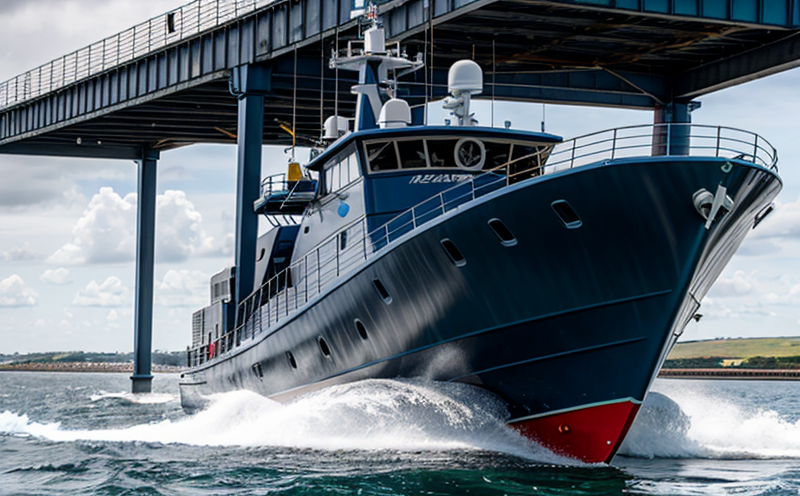ASTM G85 Seawater Fog Corrosion Testing of Propulsion Components
The ASTM G85 standard specifies the procedure for evaluating the corrosive behavior of materials under a seawater fog exposure environment. This testing method is particularly crucial for marine and ship equipment, ensuring that propulsion components can withstand the harsh environmental conditions encountered in maritime settings.
Seawater fogging involves exposing specimens to a fine mist of saltwater, which simulates the atmospheric corrosion conditions experienced by marine equipment. The test apparatus typically consists of a chamber capable of generating a fog environment with controlled temperature and humidity. Specimens are exposed for a specified duration, after which they are inspected for signs of corrosion such as pitting, cracking, or discoloration.
This testing method is essential in the quality control and compliance processes, ensuring that materials used in marine propulsion systems meet stringent industry standards. Compliance with ASTM G85 not only ensures product reliability but also aids in meeting regulatory requirements set by maritime authorities around the world.
The procedure requires meticulous specimen preparation to ensure accurate results. Specimens should be cleaned thoroughly, degreased, and dried before exposure to the seawater fog environment. The choice of materials tested can vary widely, from metals like stainless steel to composite components used in modern propulsion systems.
ASTM G85 is one of several standards that contribute to ensuring the durability and longevity of marine equipment. It complements other tests such as ASTM B117 for salt spray testing, which evaluates materials' resistance to rust under controlled conditions.
The test results are reported based on visual inspection methods, with specific criteria outlined in the standard. These criteria include the assessment of corrosion extent and depth, the appearance of any pitting or cracking, and the overall condition of the exposed material surfaces. The data is compiled into detailed reports that serve as a critical reference for quality control departments and R&D engineers.
The ASTM G85 procedure is widely recognized in the marine industry for its ability to predict real-world corrosion behavior accurately. This makes it an indispensable tool for manufacturers, suppliers, and regulatory bodies ensuring that propulsion components are robust enough to perform reliably under demanding conditions.
| Key Parameters | Description |
|---|---|
| Fogging Duration | Typically ranges from 168 hours (7 days) to 504 hours (21 days) |
| Temperature | Ranges between 23°C and 35°C depending on the standard |
| Relative Humidity | Absolute humidity controlled at a specific level to maintain fog conditions |
| Specimen Preparation | Cleaning, degreasing, and drying prior to exposure |
The ASTM G85 procedure is essential for ensuring the reliability of marine propulsion components. By simulating real-world environmental conditions, it helps manufacturers develop products that can withstand the harshness of maritime environments.
- Ensures compliance with international maritime standards
- Reduces the risk of premature failures in critical equipment
- Aids in the development of robust materials and components
- Supports regulatory compliance for export and import regulations
The ASTM G85 procedure is a vital tool for quality control departments, R&D engineers, and procurement teams. Its ability to predict real-world corrosion behavior makes it an indispensable part of the marine industry's quality assurance processes.
Industry Applications
| Application Area | Description |
|---|---|
| Metal Fabrication | Evaluating the corrosion resistance of metal alloys used in shipbuilding. |
| Marine Propulsion Systems | Testing components like propellers, shafts, and bearings for durability under seawater conditions. |
| Composite Materials | Evaluating the performance of composite materials used in modern marine equipment. |
| Metal Coatings | Determining the effectiveness of coatings applied to metal surfaces to enhance corrosion resistance. |
- Ensures compliance with international maritime standards
- Supports regulatory requirements for export and import regulations
- Aids in the development of robust materials and components for marine propulsion systems
- Reduces the risk of premature failures in critical equipment, enhancing safety at sea
The ASTM G85 procedure is widely used across various sectors within the maritime industry. It plays a crucial role in ensuring that the materials and components used in marine propulsion systems are reliable and durable under harsh environmental conditions.
Customer Impact and Satisfaction
The ASTM G85 procedure significantly impacts customer satisfaction by ensuring high-quality, reliable products. By adhering to this standard, manufacturers can deliver propulsion components that are not only durable but also comply with international standards.
Clients in the marine industry benefit from products that have undergone rigorous testing under controlled conditions, reducing the risk of failures at sea. This enhances safety and operational efficiency, ultimately leading to increased customer satisfaction.
Quality managers and compliance officers can rely on ASTM G85 for accurate and consistent results, ensuring that their procurement decisions are based on reliable data. R&D engineers also find this procedure invaluable for optimizing material selection and improving product design.
The standard's wide acceptance in the industry fosters confidence among customers, leading to long-term partnerships between suppliers and clients.
Environmental and Sustainability Contributions
- Evaluates materials for their resistance to corrosion under real-world conditions
- Promotes the use of sustainable materials that can withstand harsh marine environments
- Reduces waste by ensuring components are robust enough to last longer in service
- Supports the development of greener propulsion systems through thorough testing and material selection
The ASTM G85 procedure plays a pivotal role in promoting sustainability within the maritime industry. By ensuring that materials used in marine equipment can withstand harsh environmental conditions, it helps reduce waste and promotes the use of sustainable practices.
The standard also supports the development of greener propulsion systems by encouraging the use of durable components that require fewer replacements over their operational lifecycle. This not only reduces maintenance costs but also contributes to a more environmentally friendly approach to maritime operations.





